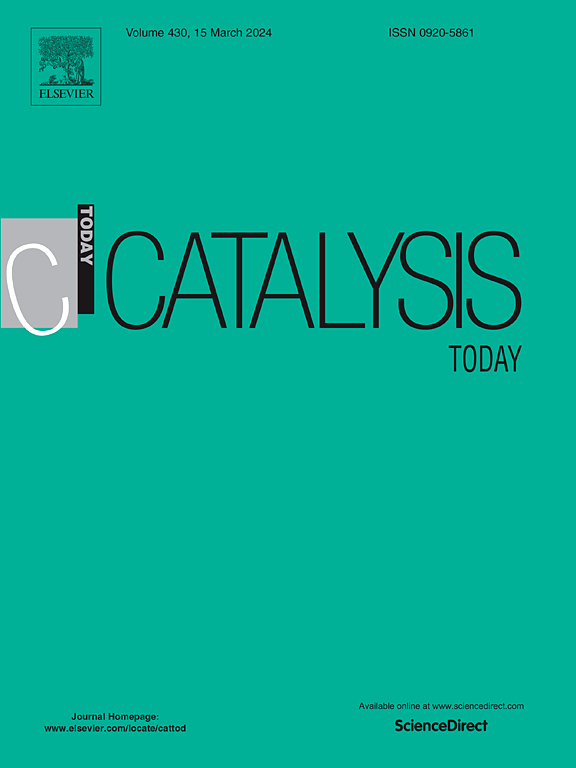Activity and selectivity for CO2 methanation of clusters and nanoplates of ruthenium dispersed on ceria: In-situ studies with XAFS and DRIFTS
IF 5.2
2区 化学
Q1 CHEMISTRY, APPLIED
引用次数: 0
Abstract
The performance of Ru/CeO2 catalysts under CO2 hydrogenation conditions was studied using in situ X-ray absorption fine structure (XAFS) and diffuse reflectance infrared Fourier transform spectroscopy (DRIFTS) to understand the structural evolution and chemical nature of each component under reaction conditions. The catalysts were prepared using a reverse microemulsion method that maximized the dispersion of RuOx particles on ceria. A RuOx → Ru transformation was observed upon exposure of the RuOx/CeO2 systems to H2 at 250 °C. For a sample with 5 % molar Ru, two-dimensional clusters (2–4 atoms) of Ru formed on top of the ceria support. An increase in the loading of ruthenium to 20 % molar led to the formation of nanoplates of the metal 2–3 at. layers thick. Both Ru structures were highly dispersed on ceria. They were oxidized after exposure to CO2 at 250 °C. However, under CO2/H2 mixture, they remained in a metallic state as two-dimensional clusters and nanoplates. In situ DRIFTS studies, the 5 % and 20 % Ru/CeO2 catalysts showed distinct reaction intermediates when exposed to CO2 or CO2/H2 (1/4) reaction mixtures. Normalized to the Ru molar percentage, the 5 % Ru/CeO2 system was the most active catalyst exhibiting a selectivity of ∼ 60 % CH4 and 40 % CO at 250 °C. On the other hand, under the same reaction conditions, the 20 % Ru/CeO2 system was less active but had a CH4 selectivity close to 80 %. These results highlight the importance of the structure of the metallic Ru particles as a factor that determines the catalytic performance.
分散在铈上的钌簇和纳米板的CO2甲烷化活性和选择性:XAFS和DRIFTS的原位研究
采用原位x射线吸收精细结构(XAFS)和漫反射红外傅里叶变换光谱(DRIFTS)研究了Ru/CeO2催化剂在CO2加氢条件下的性能,了解反应条件下各组分的结构演变和化学性质。采用反相微乳液法制备催化剂,使氧化钌颗粒在二氧化铈上的分散最大化。在250℃下,将RuOx/CeO2体系暴露于H2中,观察到RuOx→Ru转变。对于含有5 %摩尔钌的样品,在二氧化铈载体的顶部形成了Ru的二维团簇(2-4个原子)。将钌的负载增加到20 %摩尔,导致金属2-3纳米板的形成 at。层厚。两种Ru结构都高度分散在铈上。它们在250°C下暴露于CO2中被氧化。然而,在CO2/H2混合物中,它们以二维簇和纳米板的形式保持金属态。在原位DRIFTS研究中,5 %和20 % Ru/CeO2催化剂在暴露于CO2或CO2/H2(1/4)反应混合物时表现出不同的反应中间体。以Ru摩尔百分比归一化,5 % Ru/CeO2体系是最活跃的催化剂,在250°C时,CH4的选择性为~ 60 %,CO的选择性为40 %。另一方面,在相同的反应条件下,20 % Ru/CeO2体系活性较低,但CH4选择性接近80 %。这些结果突出了金属Ru颗粒结构作为决定催化性能的因素的重要性。
本文章由计算机程序翻译,如有差异,请以英文原文为准。
求助全文
约1分钟内获得全文
求助全文
来源期刊

Catalysis Today
化学-工程:化工
CiteScore
11.50
自引率
3.80%
发文量
573
审稿时长
2.9 months
期刊介绍:
Catalysis Today focuses on the rapid publication of original invited papers devoted to currently important topics in catalysis and related subjects. The journal only publishes special issues (Proposing a Catalysis Today Special Issue), each of which is supervised by Guest Editors who recruit individual papers and oversee the peer review process. Catalysis Today offers researchers in the field of catalysis in-depth overviews of topical issues.
Both fundamental and applied aspects of catalysis are covered. Subjects such as catalysis of immobilized organometallic and biocatalytic systems are welcome. Subjects related to catalysis such as experimental techniques, adsorption, process technology, synthesis, in situ characterization, computational, theoretical modeling, imaging and others are included if there is a clear relationship to catalysis.
 求助内容:
求助内容: 应助结果提醒方式:
应助结果提醒方式:


